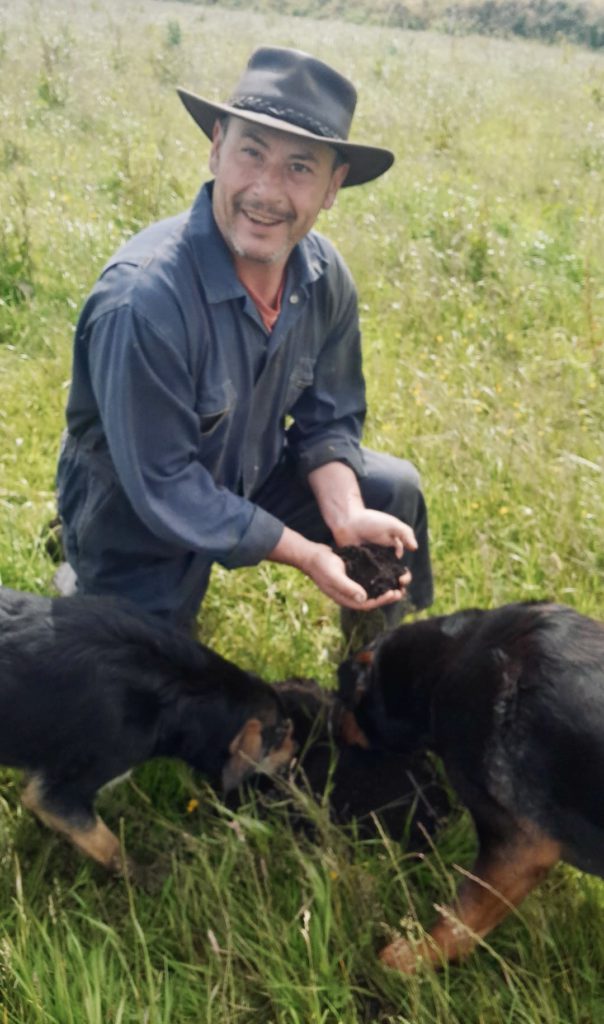Ben Richards has been awarded Third Place in the 2024 Soil Farmer of the Year competition. This case study gives an overview of how Ben has built his system around resilient soils to provide the forage and nutrition his herd. If you would like to visit Ben’s farm, a farm walk taking place on 12 September 2024: click here to book your place.
Middle Trelan Farm is a 290-acre dairy farm in Cornwall, milking 180 to 200 cows, depending on the time of year. The farm has been certified organic since 2020, with the cows being 100% grass-fed, milked once a day, calved in spring from the 10th March and outwintered to reduce costs.
Soil management has been a key focus on the farm for over 20 years, and Ben shares that making more money has consistently been a key driver in the steps taken to improve soil health and reduce inputs.

Early noughties – addressing nutrient imbalances and surface compaction
As a wet farm with heavy clay soil, an early challenge in soil management was to alleviate surface compaction, which was achieved using slit aeration.
Ben also took advice from Straight Line Nutrition, using recommended fertilisers to resolve nutrient imbalances in the soil.
2010s – phasing out chemicals and introducing herbal leys
Weaning off chemicals has been a gradual process at Middle Trelan Farm. In 2012, the decision was made to start gradually weaning off the high use of nitrogen fertiliser. Now, Ben focuses entirely on feeding the soil, not the plants, which he does by applying 2.5 tonnes/acre composted farmyard manure per year.
Having switched from blanket spraying to spot spraying broadleaf weeds in 2005, spraying was stopped altogether in 2016. It took four to five years to increase dock beetle numbers to the point where they were controlling docks. Now, with the overall reduction in chemical use, the docks have become more palatable, so what the dock beetles do not eat the cows will eat anyway.
Ben also started growing herbal leys in 2016, selecting species to benefit the soil, as well as those which will benefit the cows. This includes choosing deep-rooting species to improve the soil structure and enable water to permeate into the soil. Seed companies warned that cows would not eat some of the plants, such as sweet yellow blossom clover, but in practice, Ben has found that as the soil has improved and plants become more palatable as a result, the cows will eat all species. He has not included any ryegrass in the mix for over five years, with the exception of during Covid when the seed companies were not able to source an alternative.
For reseeding herbal leys, cows are now grazed on the area to be reseeded over winter, followed by pigs. The pigs turn over the soil and root around, preparing the ground for establishing a herbal ley in the spring.

The cows have benefitted from the move away from chemicals and the introduction of herbal leys, as they can self-medicate by selecting the nutrition they need. The evidence for this is clear, as Ben has not needed to treat the cows with any medications for eight years, although he does still give the calves an anthelmintic for lungworm.
The phasing out of chemical inputs, from broadleaf herbicides to veterinary medicines has reduced costs and therefore improved farm profitability.
2020s – moving from a bacterial soil to a fungal soil
Ben shares that it was 2021 to 2022 when the farm turned around – it had reached the point where it had a fully functioning bacterial soil. The focus has now shifted to move to a fungal-dominated soil, as with fungal mycorrhizal structures present plants can cooperate, warning each other of dangers and contributing to the overall health of the farm ecosystem.
The presence of deep-rooting plants will facilitate the transition to a fungal soil, so Ben has embarked on an agroforestry project, which is funded by Forest for Cornwall. The project began in 2023 to 2024, when 6,500 trees were planted in 1.5m rows (3 trees across 1.5m), with 12m between rows, which should be close enough for the fungal mycorrhizal structures to reach each other. Grazing trees were selected, including different varieties of willow, poplar and aspen.
The wettest fields were chosen for tree planting, with the intention that the trees will also help drain the fields, getting rid of surface water. Herbal leys have been planted between the tree rows, so in year two the trees will be grazed together with the herbal leys.
Another 4,000 trees will be planted this winter. In year three, Ben intends to stop planting and wait to see the impact during a full grazing season, then if it is working as expected he can take cuttings from the existing trees and roll out the system across the whole farm.
Ben explains that the overall goal of the agroforestry is to maximise dry matter production on-farm to feed the cows, while the trees will also help drain the fields, promote fungal activity in the soil, secure a reliable forage supply throughout the summer and also provide nutritional benefits to the cows eating them. In short, the trees should ‘tick all the boxes’ for farm resilience now and in the future.
To conclude, Ben shares that he has found it to be true that ‘less is more’. The less interfering he has to do with the cows, the better their life is, and the better his is too.

